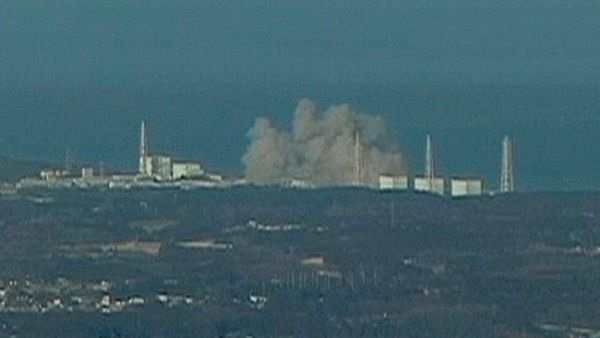by Jan Lundberg
10 July 2011

Activists are suspicious of “studying the problem” that puts off action in favor of endless talk (or publishing). Culture Change went beyond studying the problem soon after its founding in 1988: action and advocacy must get to the root of the crises to assure a livable future. Also, information overload and a diet of bad news kills much activism. So it’s hard to find reading material to strongly recommend. But the new book Nuclear Roulette: The Case Against the “Nuclear Renaissance” is must-have if one is fighting nukes today.Even for the experienced anti-nuclear campaigner, there is bound to be new material in this valuable book. It isn’t surprising, for the authors are veterans for the peace and environmental movements. Knowing them, I can vouch for their work and long term commitment: Gar Smith was the long time editor of the Earth Island Journal, and worked with the founder of Friends of the Earth, David Brower.

Ernest Callenbach is the author of the exciting novel Ecotopia. Jerry Mander wrote In The Absence of The Sacred, a worthy follow up to his Four Arguments for the Elimination of Television. Contributor Aileen Mioko-Smith, whom I do not know, is a long-time anti-nuclear activist of Japan.
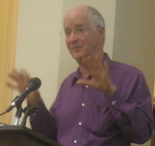
In Nuclear Roulette, profoundly sad history and information jump from almost every page. If one can for a moment forget the terrorism that the nuclear industry and its military aspect represent — to last virtually forever — a book in the class of Nuclear Roulette also has great value as a testimony to the irrational nature of an out of control elite.

If any doubt this, consider some of the shocking facts that are little known:
• In 2000 alone, civilian reactors in the U.S. produced enough plutonium — the most dangerous substance in the known universe — to make 34,000 nuclear bombs. What were they for? Wasn’t the cold war over, and had not a Democrat been in the White House for almost two complete terms?• “An average 1,000 MW reactor contains approximately 16 billion curies of radioactive material — the equivalent of 10,000 Hiroshima bombs. Tritium, krypton, xenon-135, iodine-131 and iodine-129 (with a radioactive half-life of 16 million years) are routinely vented into the air, contaminating downwind rivers, land and residents.”
Tightly but passionately written, Nuclear Roulette was published in June, 2011, begun well before Fukushima blew. Three long-time writer/activists working under the umbrella of the San Francisco, California-based International Forum on Globalization got together to demolish the nuclear power scam. Lead author Gar Smith teamed up with Ernest Callenbach, Aileen Mioko-Smith and Jerry Mander to write and edit a definitive, up to date book on the nuclear threat. The problems of nuclear technology, the lies of the nuclear energy/weapons establishment, and the impossibility of endless industrial growth are well addressed, and a wide-ranging approach to alternative economic/energy technology is presented.Without a major accident in several years up until the General Electric/TEPCO’s disaster with Fukushima, and with growing concern worldwide about greenhouse gas accumulation, nuclear energy had been repeatedly portrayed as meeting “needs” for economic growth. There is nothing clean about nuclear power, but the fact that the form of energy is (1) not producing visible contaminants as do fossil-fueled stations, or (2) is CO2-free at the stations, the claim is that nuclear is the best way to go or at least deserves to be part of the energy diet. However, this weak logic is clear when the waste dilemma and warhead issues are considered — not to mention a Chernobyl or a Fukushima. And the financial, insurance and net-energy issues with nukes are incurable. So Nuclear Roulette: The Case Against the “Nuclear Renaissance” is a solid attempt to build on the post-Fukushima momentum (at least in some countries) to defeat the resurgent pro-nuclear forces. The Fukushima disaster should have done the job many times over, but activists and citizens cannot rest.
The uneconomic nature of nuclear power, and the lack of energy gain compared to cheap oil, are two huge reasons for society to quit flirting with more nuclear power, never mind the catastrophic record and certainty of more to come. Somehow the evidence and true track record of dozens of accidents and perhaps 300,000 to nearly 1,000,000 deaths from just Chernobyl, are brushed aside by corporate media and most governments. So, imaginative means of helping to end nuclear proliferation are crucial, the most careful and reasonable-sounding ones being included in summary form in Nuclear Roulette.
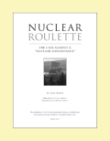
The nuke industry lies continue, and President Obama is on the wrong side: against humanity and countless species. Consider: “Whenever a nuclear accident spews an unusual amount of radiation into the local air, industry spokespeople invariably assure the public that the release ‘poses no harm.’ But radioactive fallout, no matter how small, is not neutral and the industry knows this. There is no ‘safe-level’ of nuclear exposure: all exposure to ionizing radiation is potentially harmful.” (John Goffman, 1990, nuclear whistleblower, from the book)
Similar to this lie is deception about radiation. Background or natural radiation, from a nuclear accident or part of routine release, once dissipated sometimes barely show up when compared to other forms of natural exposure. One is told that flying in a jet, or getting a lot of sun, or getting teeth X-rayed, is more radiation than nuclear power’s contribution. However, even if sudden, massive exposures from explosions, meltdowns and fuel rods burning are left aside for a moment, the deception in the background radiation argument is that internal radioactivity mounts, not just external radioactivity. In the air, food, water and soil, over much of the northern hemisphere now, it is the particles of radioactive isotopes that even singly cause lung cancer, bone cancer, and other types of cancer.
With the book’s rousing prologue, I thought it would climax with an appeal for massive civil disobedience. It does not go there all-out, perhaps because a Gandhian protest movement is barely glimpsed even by many activists in the U.S. Gandhi is quoted in Nuclear Roulette to showcase his awareness of resource domination and waste. Activist Mioko-Smith concludes her section wisely with “Should we take to the streets?”
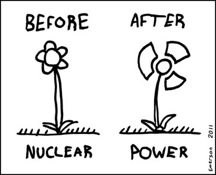
It’s not as if the problems and crises with nuclear power are new, such that a shocking report could bring about action. It is sad that nuclear’s evil and nasty poison have been on display — though hidden as best the moneyed interests and corporate media could do — for decades. Except for the unpleasant details of the Fukushima catastrophe, nothing new can be said. It is time for action. Yet, more people must become aware and motivated to act.
“Better Options Exist”
Nuclear Roulette is extremely informative and is a good tool for fighting nukes. To hope that the facts will change policy when shown to the corporate state — including the few friendly, anti-nuke tokens in government — would be to delude ourselves. And if alternative energy and locally designed ecocities or Transition Towns are offered as the solution without massive lifestyle change to physically reject the idea of monstrous energy requirements for today’s overgrown mass of consumers, then we have not progressed. Fortunately, the “power down” concept is part of the book’s solutions section at the end. The discussion bolsters the chance of convincing some more people that nuclear power is a tragic mistake.
The question, “who is this book written for” may be answered with “those who have an appetite for more information and who are willing to help put a handy new volume (a large, thin paperback booklet of 76 pages) into circulation.” Every home, school, library and workplace should have a copy of Nuclear Roulette for reference.
Chief author Gar Smith sums up the current nuclear crisis: “If Japan, one of the world’s most technologically sophisticated countries, cannot assure the safety of nuclear power, it is time to consider the only rational course of action — the commencement of an immediate global decommissioning process.” Who can disagree? In the Prologue, editors Callenbach and Mander allow emotion to properly enter into the “debate” on nuclear power: “What madness!”
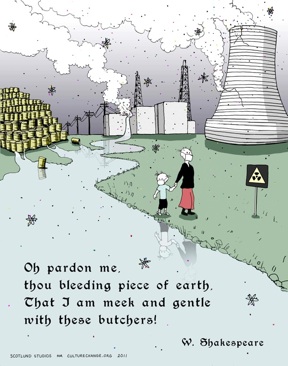
Nuclear Roulette has one picture of a protest, which might have been civil disobedience, and five pictures of alternative energy. Thirteen pictures or graphs are about the dangers of nukes. The layout is superb, and the presentation well organized. Is there a piece missing in this short book? The book cannot say everything and still attract many readers, so perhaps it does not matter if people do or don not discuss all the issues exhaustively, when this relatively simple, new book may stimulate taking action.
As for solutions, less energy and non-fossil/nuclear energy options are discussed. But for the “Zero CO2 Economy” to come about, can The System reform itself? Collapse of the growth economy, fossil-fuel driven climate distortion, and a catastrophic petroleum-famine are the main drivers of fundamental change — not policies or so-called decision makers. However, examining collapse in indirectly possible through Nuclear Roulette: Bay Localize’s Community Resilience Handbook is offered as an explicit resource for post-oil living and organizing in the present. An appendix in the Handbook is “Our Post-Peak Oil Future” (co-authored by yours truly) which discusses sudden collapse via oil industry failure versus a more optimistic, slow collapse of civilization.
A follow-up companion booklet from the authors and publisher of Nuclear Roulette might be a discussion of how The System can most quickly be ushered into the past, peacefully, where it belongs. Nuclear poison will be with us for eternity, so an unwanted job for a significant portion of humanity will forever be to “babysit the nukes.” Perhaps this is why nuclear proliferators have offspring?
* * * * *

Further reading:
Nuclear Roulette is available from the International Forum on Globalization (IFG) for $16 (plus $3 postage). It is “No. 5 in the IFG series focused on False Solutions to the global climate crisis.” Reach IFG through email at ifg “at” ifg.org or visit the website ifg.org
Gar Smith’s website Environmentalists Against War
Radioactive isotopes or “hot particles”: Arnie Gunderson, noted US nuclear engineer, writes at fairewinds.com. Culture Change has not studies carefully enough to offer definitive information, but certain foods and precautions lessen risk: eat miso, seaweed not from the northern Pacific, and other foods or substances, and avoid unwashed foods that may have accumulated particles. Look into this, and if you can submit or recommend a well-researched article, we would be interested. Thank you, Jan Lundberg for Culture Change.
Read any of several nuclear related articles on Culture Change.

